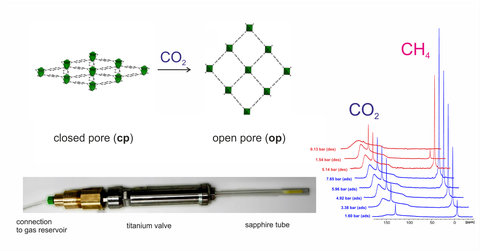P1: Experimental Analysis of the Switching Process and its Dynamics by in situ NMR Spectroscopy
Eike Brunner
The project aims to further develop the fundamental understanding of the pronounced structural changes (switching) observed for flexible MOFs under external stimuli. This includes two aspects, namely an understanding of the underlying molecular interactions/processes as well as the dynamics/kinetics of the switching process. The investigations on flexible MOFs are devoted to the development of in situ techniques within this DFG Research Unit. Our studies on MOF samples synthesized within sub-projects S1 and S2 will also encompass investigations concerning the effect of the synthesis parameters, the crystallite domain size and others. The planned investigations will be mainly based on in situ NMR spectroscopy, complemented by in situ optical spectroscopy. Comparison with the results of in situ X-ray diffraction (S2) and in situ EPR spectroscopy (P2) is likely to deliver a more comprehensive understanding for the switching process. The project substantially gains from the collaboration with theoretical groups (T1,T2). Quantum chemical calculations and molecular dynamics simulations are necessary, e.g., for chemical shift calculations, determination of preferred interaction sites, averaging along molecular trajectories etc.
The present research project thus aims to address the following open questions:
- What are the crucial properties and molecular interactions determining the switching process and its dynamics? Answering this question will help designing flexible MOFs with “tuned” properties.
- How does the switching process depend on external stimuli? These studies aim to understand the influence of the type of gas or gas mixture, of temperature and pressure.
- What is the time scale of the switching process? The corresponding investigations will provide quantitative information on kinetics as a function of external parameters (type of gas/ gas mixture, temperature, pressure) – an important parameter with respect to possible applications.
In situ NMR spectroscopic adsorption/desorption studies will be performed in order to study the gate opening/closure processes as a function of temperature, pressure and type of adsorbed gas. Gases such as 129Xe, 13CO2, 13CH4, and others are being used. In addition, in situ optical spectroscopy is used for studying the switching kinetics, especially for DUT-8(Ni) with its pronounced color change during switching. Liquid-state adsorption processes on flexible MOFs will be investigated by solid-state NMR spectroscopy. The full arsenal of modern solid-state NMR spectroscopy will be applied in order to characterize the MOF framework and the structural changes of the MOF.

Fig. 1: In situ-NMR spectroscopy reveals the selective adsorption of CO2 exposed to a CH4/CO2 mixture at varying pressure.
H. C. Hoffmann, B. Assfour, F. Epperlein, N. Klein, S. Paasch, I. Senkovska, S. Kaskel, G. Seifert, E. Brunner, “High-Pressure in Situ 129Xe NMR Spectroscopy and Computer Simulations of Breathing Transitions in the Metal-Organic Framework Ni2(2,6-ndc)2(dabco) (DUT-8(Ni))”, J. Am. Chem. Soc. 2011, 133, 8681-8690.
V. Bon, J. Pallmann, E. Eisbein, H.C. Hoffmann, I. Senkovska, I. Schwedler, A. Schneemann, S. Henke, D. Wallacher, R.A. Fischer, G. Seifert, E. Brunner, S. Kaskel, “Characteristics of flexibility in metal-organic framework solid solutions of composition [Zn2(BME-bdc)x(DB-bdc)2-xdabco]n: In situ powder X-ray diffraction, in situ NMR spectroscopy, and molecular dynamics simulations”, Microporous Mesoporous Mater. 2015, 216, 64-74.
M. Sin, C. Kutzscher, I. Senkovska, T. Ben, S. Qiu, S. Kaskel, E. Brunner, “Surface polarity estimation of metal-organic frameworks using liquid-phase mixture adsorption”, Microporous Mesoporous Mater. 2017, 251, 129-134.
K. Trepte, J. Schaber, S. Schwalbe, F. Drache, I. Senkovska, S. Kaskel, J. Kortus, E. Brunner, G. Seifert, “The origin of the measured chemical shift of 129Xe in UiO-66 and UiO-67 revealed by DFT investigations”, Phys. Chem. Chem. Phys. 2017, 19, 10020-10027.
J. Schaber, S. Krause, S. Paasch, I. Senkovska, V. Bon, D. Toebbens, D. Wallacher, S. Kaskel, E. Brunner, “In Situ Monitoring of Unique Switching Transitions in the Pressure-Amplifying Flexible Framework Material DUT-49 by High-Pressure 129Xe NMR Spectroscopy”, J. Phys. Chem. C 2017, 121, 5195–5200.
N. Kavoosi, V. Bon, I. Senkovska, S. Krause, C. Atzori, F. Bonino, J. Pallmann, S. Paasch, E. Brunner,, S. Kaskel, “Tailoring adsorption induced phase transitions in the pillared-layer type metal-organic framework DUT-8(Ni)”, Dalton Trans. 2017, 49, 4685-4695.
K. Trepte, S. Schwalbe, J. Schaber, S. Krause, I. Senkovska, S. Kaskel, E. Brunner, J. Kortus, G. Seifert, “Theoretical and experimental investigations of 129Xe NMR chemical shift isotherms in metal-organic frameworks”, Phys. Chem. Chem. Phys. 2018, 20, 25039-25043.
H. Bunzen, F. Kolbe, A. Kalytta-Mewes, G. Sastre, E. Brunner, D. Volkmer, “Achieving large volumetric gas storage capacity in metal-organic frameworks by kinetic trapping: A case study of xenon loading in MFU-4”, J. Am. Chem. Soc. 2018, 140, 10191-10197.
M. Sin, N. Kavoosi, M. Rauche, J. Pallmann, S. Paasch, I. Senkovska, S. Kaskel, E. Brunner, “In situ 13C NMR spectroscopy study of CO2/CH4 mixture adsorption by metal-organic frameworks: Does flexibility influence selectivity?”, Langmuir 2019, 35, 3162-3170.
